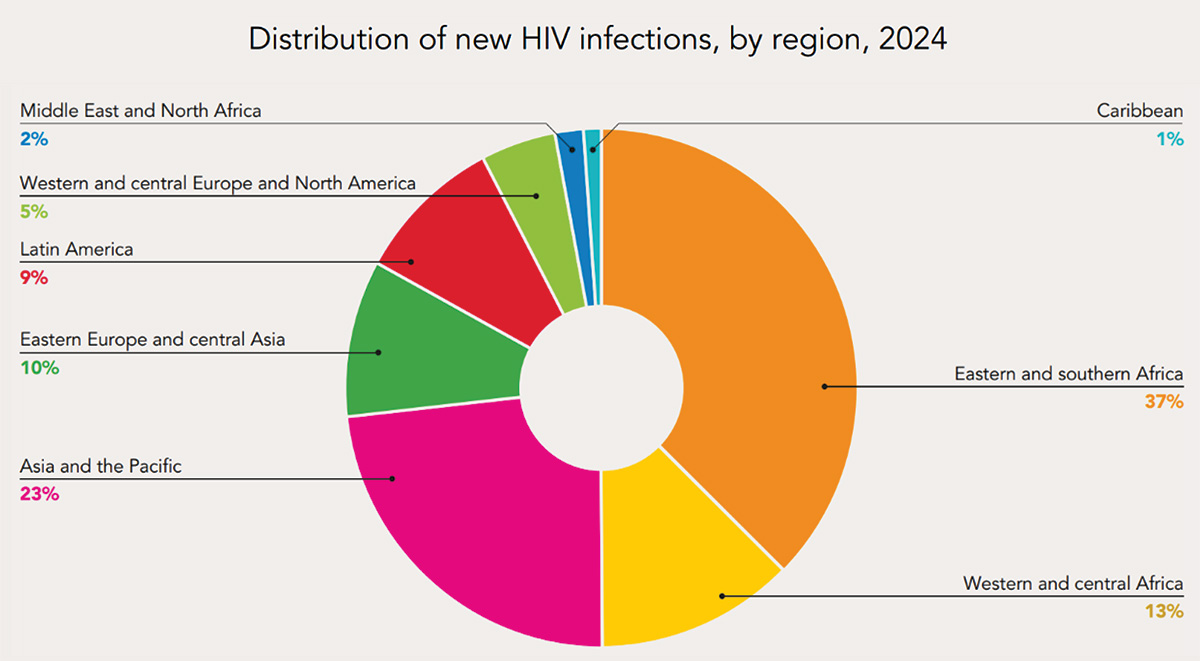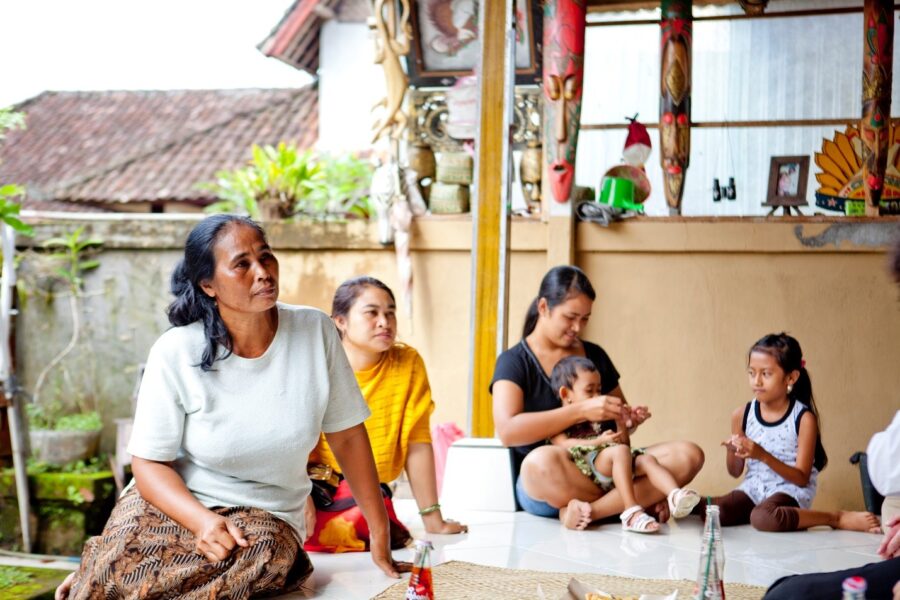HIV/AIDS in the World
- Approximately 40.8 million people worldwide are living with HIV.
- Deaths from AIDS-related causes were estimated to be 630,000 in 2024.
- 53% of all people living with HIV (PLWH) are women and girls.
- While 87% of PLWH were aware of their status in 2024, approximately 5.3 million did not know they were living with the virus.
- The age group least likely to receive HIV treatment—children aged 0-14.
- An estimated one-quarter (26%) of all people living with HIV were 50 years and older in 2024.
- Two-thirds of PLWH reside in sub-Saharan Africa.

New HIV infections
- New HIV infections totaled 1.3 million, a decline of 61% since the peak in 1996.
- Roughly 3,500 adults and children acquire HIV each day.
- In 2024, 40% fewer people acquired HIV compared with 2010.
- Members of key populations (men who have sex with men, people who inject drugs, sex workers, transgender women, and people who are incarcerated) and their sex partners accounted for over 50% of new infections.
- New infections have risen in at least 32 countries since 2010.
AIDS-related deaths
- Annual deaths from AIDS-related causes were estimated to be 630,000 in 2024, or one death every minute. Thanks to HIV testing and treatment access, there were 54% fewer AIDS-related deaths in 2024 than in 2010.
- Eastern and southern Africa is the region with the most AIDS-related deaths: 260,000; Asia and the Pacific have the next highest number: 150,000. North America and western and central Europe have the least: 9,000.
- In 2024, 75,000 children died of AIDS-related causes.

Access to treatment
- 31.6 million people (77% of all PLWH) were accessing antiretroviral therapy in 2024.
- Half of the 9.2 million people in need of HIV treatment live in sub-Saharan Africa; 25% live in Asia and the Pacific.
- Along the continuum of care for all: 87% of PLWH knew their status in 2024; among them, 89% had accessed antiretroviral therapy; and 94% of PLWH on treatment had achieved viral suppression. By category:
- Women (aged 15+ years): 92%-91%-95%
- Men (aged 15+ years): 84%-87%-94%
- Children: 63%-87%-86%
Access to Prevention Options/PrEP
- Oral PrEP use continued to increase, from a little over 200,000 in 2017 to about 3.9 million in 2024. However, the number of people who could benefit from PrEP is estimated to be 21.2 million.
- In 2024, external funding financed almost 80% of HIV prevention in sub-Saharan Africa, 66% in the Caribbean, and 60% in the Middle East and North Africa.
HIV Among Key Populations
- Key population programs, predominantly community-led groups and other nongovernmental organizations, are underfunded across all regions and now also threatened by funding cuts. People from key populations and their sex partners account for over 50% of all new HIV infections.
- HIV prevalence among adults (aged 15–49) was 0.7% globally. Within key population groups, median HIV prevalence was higher.
- 8.5% among transgender people
- 7.6% among gay men and other men who have sex with men
- 7.1% among people who inject drugs
- 2.7% among sex workers
- 1.4% among people in prisons
HIV Among Adolescent Girls and Young Women/Adult Women
- Gender-based violence impacts individuals beyond physical and traumatic effects—studies show that this type of violence increases HIV infection risk in countries with high HIV prevalence and decreases prevention uptake and use of services.
- In 2024, 45% of all new infections occurred among women and girls, including an estimated 210,000 infections among adolescent girls and young women—570 new infections per day.
- In general, women more than men have seen stronger declines in numbers of new infections (though HIV incidence is still extremely high in parts of eastern and southern Africa and western and central Africa).
- Globally, 4,000 adolescent girls and young women aged 15–24 acquired HIV every week, with 3,300 of these infections occurring in sub-Saharan Africa.
- In 2024, 84% of pregnant and breastfeeding women living with HIV had access to antiretroviral treatment to prevent transmission of HIV to their children. However, there has been very little increase in this type of treatment coverage over the past decade.

HIV Among Children
- The age group least likely to receive HIV treatment—children aged 0-14.
- Approximately 120,000 children (under 15) newly acquired HIV in 2024 globally, with the most impacted regions being eastern and southern Africa (55,000), western and central Africa (43,000), and Asia and the Pacific (11,000).
- Children aged 0–14 years had the steepest decreases in numbers of new HIV infections, declining by 62% from 2010 to 2024.
- Between 2000 and 2024, programs to prevent vertical (mother-to-child) transmission of HIV averted nearly 4.4 million new HIV infections in children.
- In 2024, an estimated 75,000 children died of AIDS-related causes—12% of all AIDS-related deaths, even though children are only 3% of all people living with HIV.
- In total, roughly 1.4 million children were living with HIV in 2024, with an estimated 620,000 not receiving treatment. Approximately 40% of children not receiving treatment were under the age of five, a time of increased risk of death.
- In 2024, 63% of children living with HIV knew their status; 87% of those who knew their status were on ART (57% of all children living with HIV were on ART); and 86% of those who knew their status had achieved viral suppression (48% of all).
The Regional Picture (2024)
Eastern and southern Africa
- People living with HIV: 21.1 million
- New infections: 490,000
- AIDS-related deaths: 260,000
- People living with HIV on ART: 84%
- This region accounts for 52% of the global AIDS burden, but progress has been made—a 56% decrease in new HIV infections, as well as a 59% decrease in AIDS-related deaths since 2010. Adolescent girls and young women aged 15–24 years accounted for 28% of new HIV infections. Conflict, climate shocks, and displacement increasingly disrupt HIV services in the region.
Asia and the Pacific
- People living with HIV: 6.9 million
- New infections: 300,000
- AIDS-related deaths: 150,000
- People living with HIV on ART: 69%
- Fewer than 250,000 people are accessing PrEP, much lower than the target of 8 million.
- Antiretroviral coverage for people living with HIV is uneven across the region; 90% in Cambodia accessed treatment, but coverage fell below 50% in Afghanistan, Bangladesh, Fiji, Indonesia, Mongolia, Pakistan, Papua New Guinea, and the Philippines
Western and Central Africa
- People living with HIV: 5.2 million
- New infections: 160,000
- AIDS-related deaths: 120,000
- People living with HIV on ART: 76%
- New HIV infections in this region account for 13% of annual new infections globally.
- Adolescent girls and young women (aged 15–24) were three times more likely to acquire HIV than their male counterparts. Only half of pregnant women living with HIV are receiving antiretrovirals to prevent vertical (mother-to-child) transmission.
Latin America
- People living with HIV: 2.5 million
- New infections: 120,000
- AIDS-related deaths: 27,000
- People living with HIV on ART: 71%
- Since 2010, AIDS-related deaths have decreased by 31%. Annual new HIV infections have increased by 13%. Only approximately 250,000 people accessed PrEP, far from the regional target of more than two million by 2025.
The Caribbean
- People living with HIV: 340,000
- New infections: 15,000
- AIDS-related deaths: 4,800
- People living with HIV on ART: 74%
- In this region, new HIV infections decreased by 21% since 2010. However, four countries—Cuba, Dominican Republic, Jamaica, and Haiti—make up nearly 90% of these new infections. Only 36% of children living with HIV are on ART.
Middle East and North Africa
- People living with HIV: 240,000
- New infections: 23,000
- AIDS-related deaths: 7,000
- People living with HIV on ART: 48%
- In this region, new HIV infections increased by 94% since 2010. Young people (aged 15–24) make up an estimated 23% of new HIV infections. People from key populations have the highest HIV prevalence.
Eastern Europe and central Asia
- People living with HIV: 2.1 million
- New infections: 130,000
- AIDS-related deaths: 48,000
- People living with HIV on ART: 51%
- Eastern Europe and central Asia is the only region where the number of AIDS–related deaths is still increasing. HIV prevalence is highest among people from key populations.
Western and central Europe and North America
- People living with HIV: 2.4 million
- New infections: 62,000
- AIDS-related deaths: 9,000
- People living with HIV on ART: 80%
- This region has seen a 14% decrease in new HIV infections since 2010. Coverage of HIV testing and treatment services remained high in Western and Central Europe (though with Central Europe doing more poorly than Western Europe).
Sources
UNAIDS Global AIDS Update 2025
UNAIDS Global HIV & AIDS Statistics Fact Sheet 2025